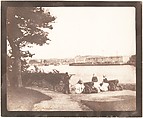Plymouth from Mt. Edgcumbe
William Henry Fox Talbot British
Not on view
Talbot was a man of great learning and broad interests, from Egyptology to mathematics, botany, and chemistry. His invention of the negative-positive photographic process, announced to the public in 1839, changed the dissemination of knowledge as had no other since movable type.
This view shows a late summer outing in Plymouth on the property of Talbot's sister Caroline, who had married the Earl of Mount Edgcumbe. The subjects are recorded as two "Miss McDonalds," Talbot's wife Constance, and an unidentified man with the telescope, likely the amateur photographer the Rev. Calvert R. Jones. Across the way is the Royal Navy's new Victualling Office, designed by Sir John Rennie and completed in the 1830s. The block of buildings housed a slaughterhouse, a brewhouse, and an enormous mill and bakery capable of processing 270,000 pounds of flour per week. The self-contained food-and-drink manufacturing complex was commissioned to provide for the needs of the entire British fleet and specifically designed to serve the navy in periods of crisis.
Due to rights restrictions, this image cannot be enlarged, viewed at full screen, or downloaded.

